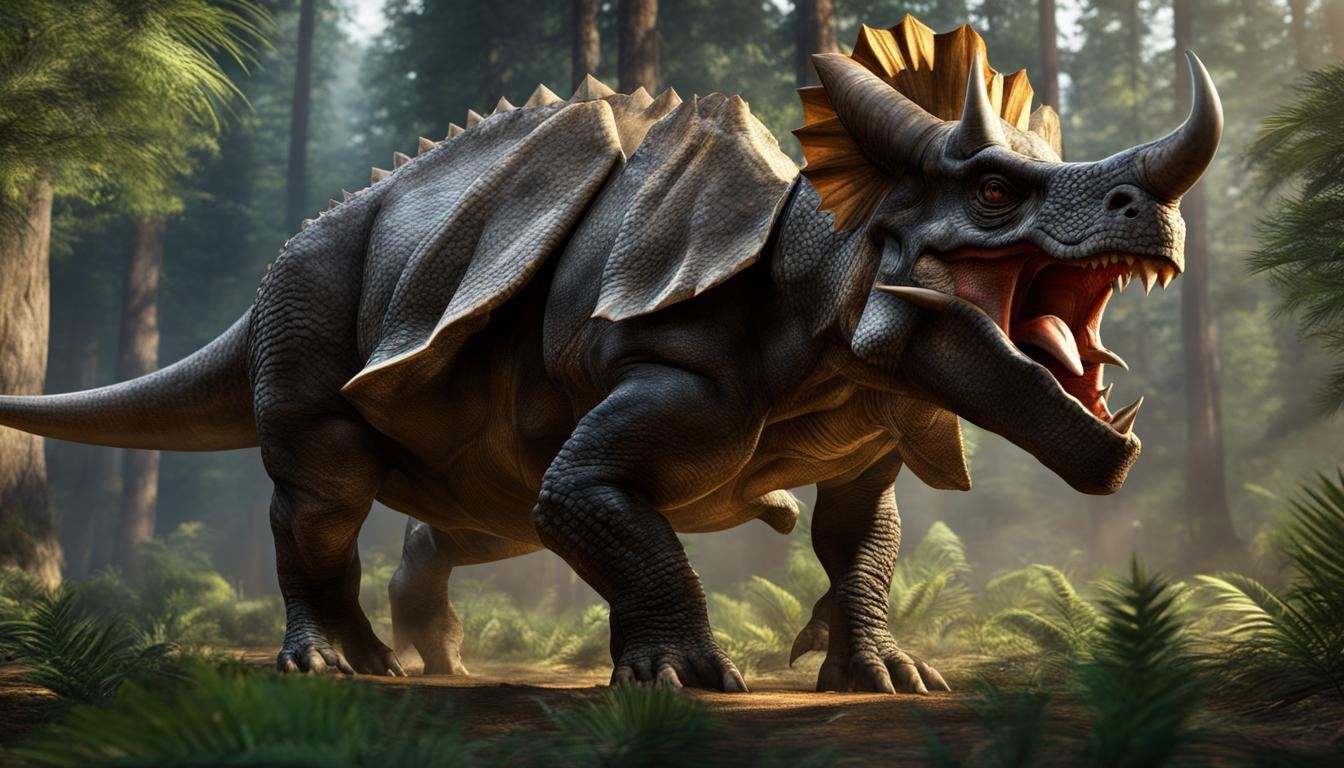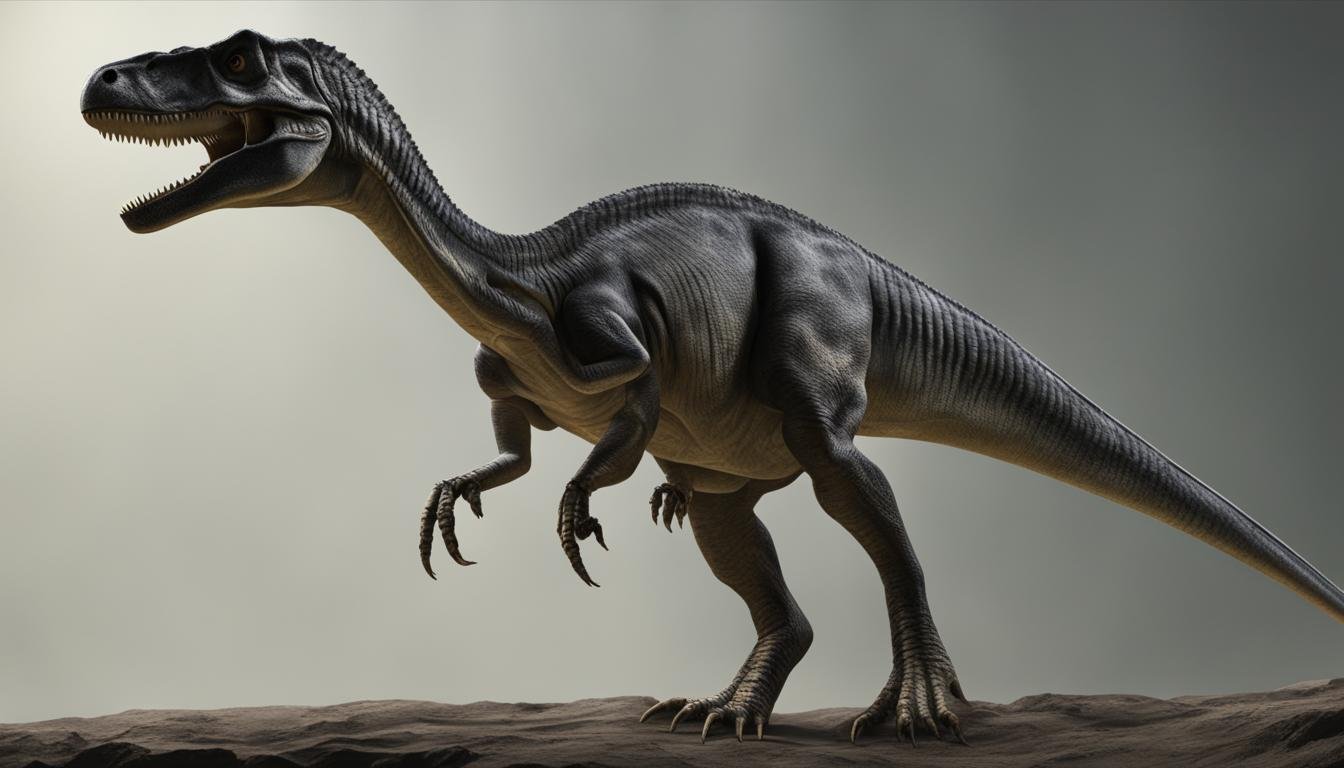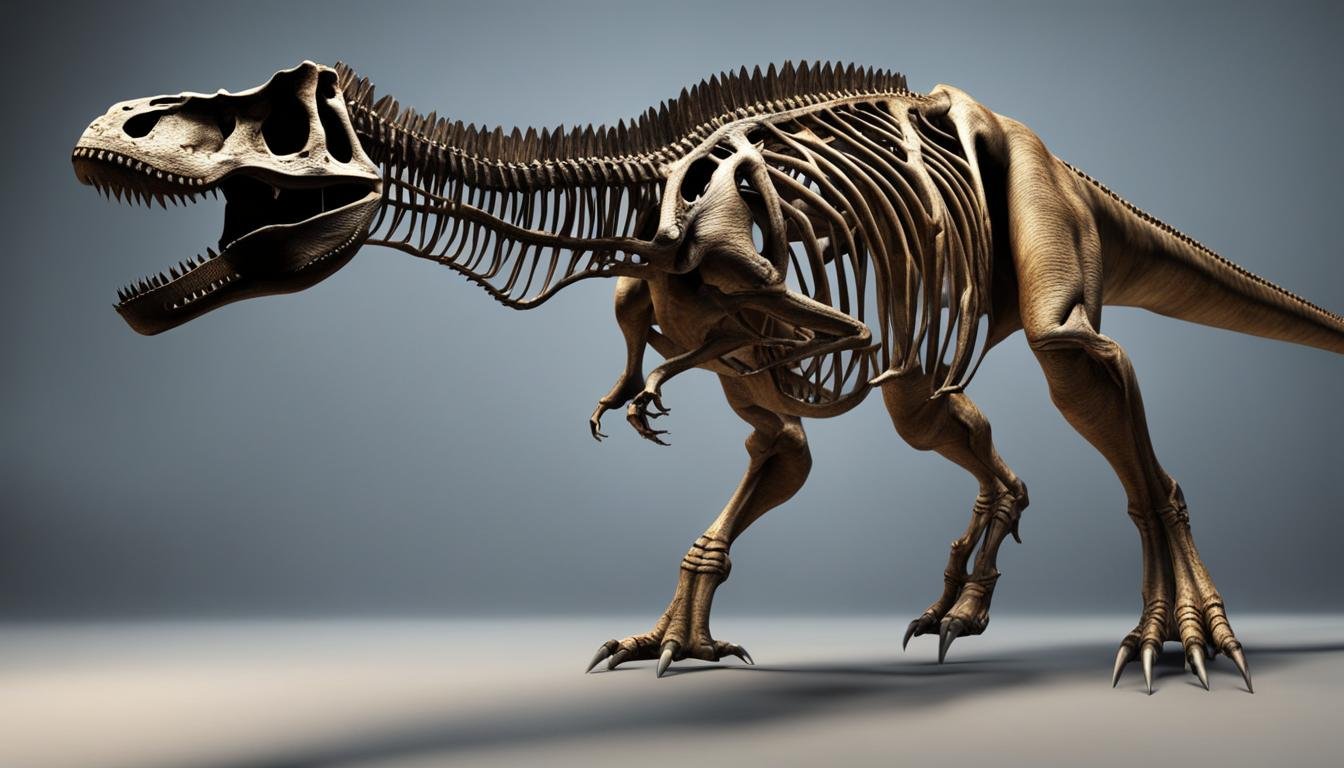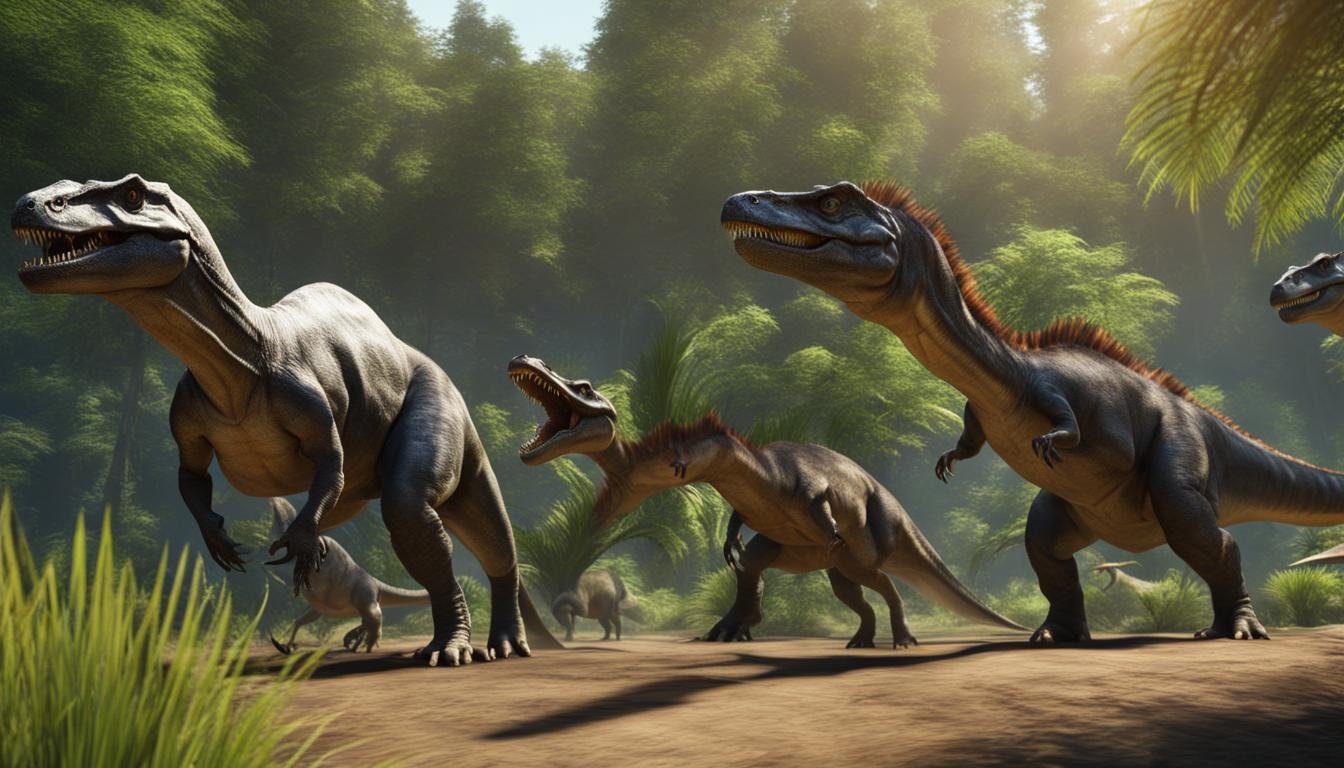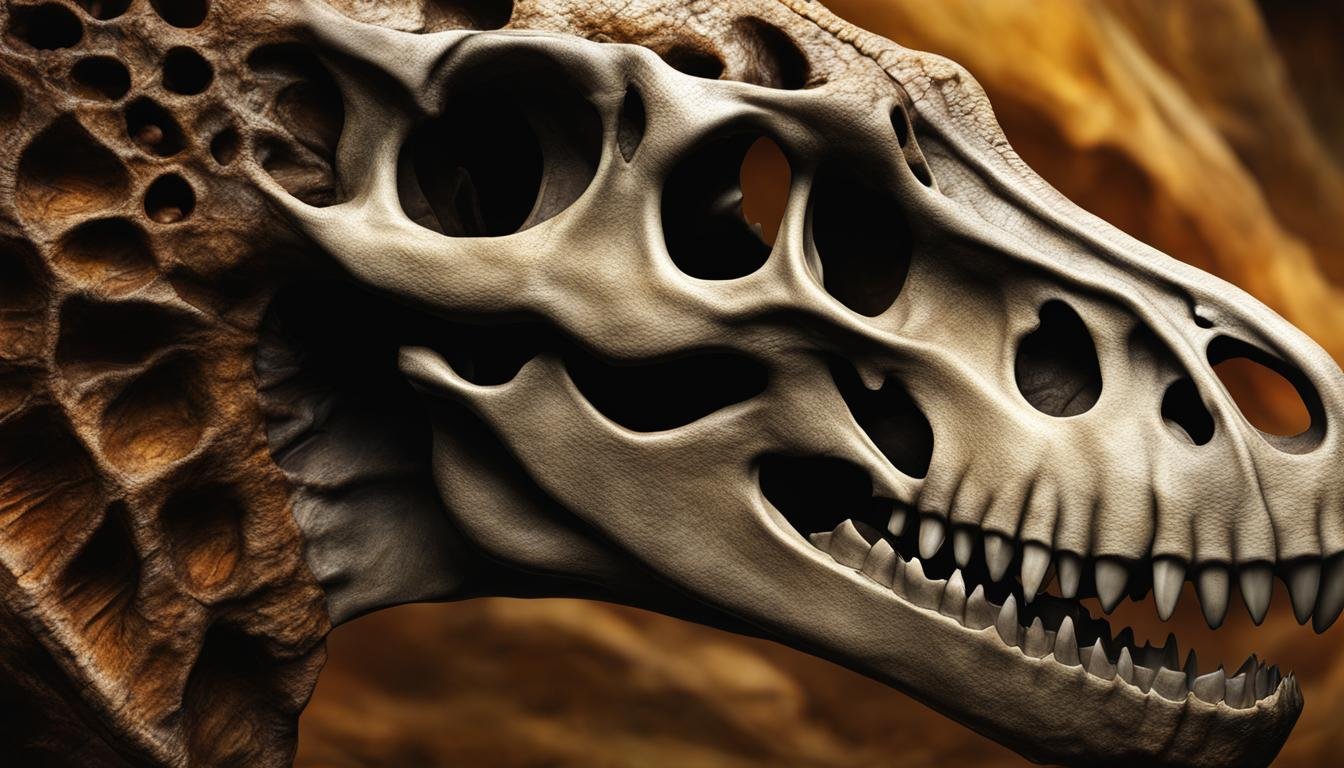Welcome to our exciting exploration of defense mechanisms in dinosaur anatomy! Dinosaurs, the magnificent creatures that roamed the Earth millions of years ago, developed a range of fascinating adaptations to protect themselves from predators. In this article, we will delve into the physical traits and behavioral strategies that allowed dinosaurs to survive in a dangerous and competitive prehistoric world. Get ready to uncover the secrets of their defense mechanisms and gain a deeper understanding of dinosaur anatomy!
Physical Adaptations for Defense
Dinosaurs developed an array of physical adaptations that served as defense mechanisms against predators. These adaptations allowed them to survive in their dangerous prehistoric environments. Let’s explore some of the key physical features that dinosaurs evolved for defense:
Claws
Many dinosaurs had sharp, hooked claws that they used as weapons to fend off predators. These claws were especially effective for slashing and gripping, enabling the dinosaurs to inflict damage and escape dangerous situations.
Head Butting
Some dinosaurs, such as the Pachycephalosaurs, had thick, bony skulls that they used for head butting. By forcefully ramming into their opponents, they could defend themselves and establish dominance within their own species.
Whipping Tails
Other dinosaurs, like the Ankylosaurs, had heavily armored tails with clubs or spikes at the ends. These tails could be swung rapidly, providing a powerful defense against attackers. The impact from a whipping tail could cause serious injury or discourage predators from pursuing the dinosaur further.
These physical adaptations demonstrate the incredible diversity and ingenuity of dinosaurs in developing defense mechanisms. By examining these features, we can gain a deeper understanding of how these ancient creatures thrived in a world filled with danger and predators.
| Dinosaur | Claws | Head Butting | Whipping Tails |
|---|---|---|---|
| Velociraptor | Sharp and curved | – | – |
| Pachycephalosaurus | – | Thick, bony skull | – |
| Ankylosaurus | – | – | Heavily armored tail with club/spikes |
This table shows a comparison of the physical adaptations for defense in different dinosaur species. While the Velociraptor primarily relied on its sharp claws, the Pachycephalosaurus used its thick skull for defense, and the Ankylosaurus had a powerful, armored tail.
Through these physical adaptations, dinosaurs were able to survive and thrive in a world filled with danger. Their claws, head butting abilities, and whipping tails allowed them to fend off predators and protect themselves in the ancient ecosystem.
Body Armor in Dinosaurs
Dinosaurs had a fascinating array of body armor that provided them with an extra layer of defense against predators. This armor came in various forms, including horns, plates, and spikes, and it played a crucial role in their survival.
Types of Body Armor
One type of body armor seen in dinosaurs is the presence of horns. These bony structures, such as those found in the Triceratops, acted as formidable weapons, helping dinosaurs fend off attackers. Another form of body armor was plates, which were often arranged in rows or clusters and served as a protective shield for vital areas of dinosaurs’ bodies.
In addition, some dinosaurs had spikes protruding from their bodies. These spikes, like those found on the Stegosaurus, not only acted as defense mechanisms but also served as a display feature to intimidate potential threats.
Protection and Survival
The body armor of dinosaurs played a crucial role in their survival in dangerous environments. It provided them with protection against predators and allowed them to engage in combat and territorial disputes. By having an extra layer of defense, dinosaurs increased their chances of survival and ensured the continuation of their species.
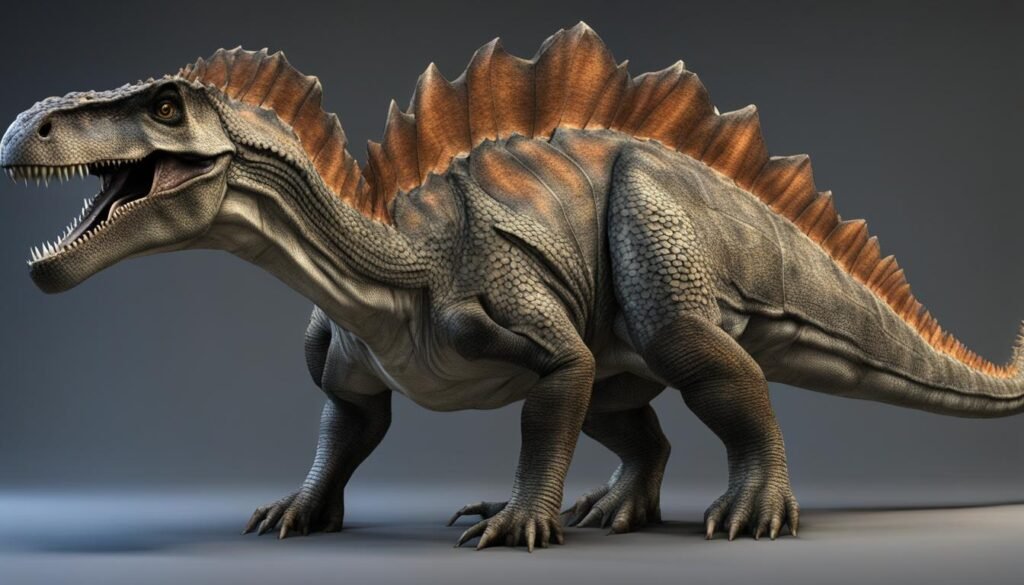
Use of Camouflage and Mimicry
Dinosaurs employed a variety of defense mechanisms to protect themselves from predators. One of these strategies was the use of camouflage and mimicry. By blending into their surroundings or mimicking other dangerous animals, certain dinosaurs were able to avoid detection and increase their chances of survival.
Camouflage allowed dinosaurs to hide in plain sight. Some dinosaurs had color patterns and markings that helped them blend in with their environment, making it difficult for predators to spot them. For example, the dinosaur Deinonychus had a coloration that matched the foliage of its habitat, allowing it to effectively disappear from view. Similarly, the predator Carnotaurus had a mottled pattern on its skin that allowed it to blend in with the sun-dappled forest, making it virtually invisible to unsuspecting prey.
“Camouflage allowed dinosaurs to hide in plain sight.”
Mimicry was another ingenious defense tactic used by certain dinosaurs. Some dinosaurs evolved to resemble other dangerous or unappealing animals, fooling predators into thinking they were not worth the effort. One example of dinosaur mimicry is the Thescelosaurus, which had a body shape and structure similar to the spiky and heavily armored Stegosaurus. By closely resembling the formidable Stegosaurus, the Thescelosaurus was able to deter potential predators.
Overall, the use of camouflage and mimicry was a highly effective defense strategy for dinosaurs. By blending into their surroundings or resembling other dangerous animals, dinosaurs were able to avoid detection and increase their chances of survival in a world filled with predators.
| Dinosaur | Camouflage Adaptation |
|---|---|
| Deinonychus | Coloration matching foliage, blending into the environment |
| Carnotaurus | Mottled pattern on skin, blending in with sun-dappled forest |
| Thescelosaurus | Resembles heavily armored Stegosaurus, fooling predators |
Diverse Locomotion Strategies
Dinosaurs had a wide range of locomotion strategies that allowed them to navigate and move effectively in their respective environments. These strategies varied depending on the dinosaur’s body structure, habitat, and overall adaptation. Let’s explore some of the most prominent locomotion strategies employed by dinosaurs.
Bipedalism: Walking on Two Legs
One of the most well-known locomotion strategies used by dinosaurs is bipedalism, where dinosaurs walked on two legs. This adaptation was particularly common among theropods, such as the iconic Tyrannosaurus rex. Bipedal dinosaurs had strong hind limbs, enabling them to move quickly and efficiently. They used their forelimbs for balance and grasping objects, making them formidable predators or agile prey, depending on their size.
Quadrupedalism: Walking on Four Legs
In contrast to bipedal dinosaurs, many species were quadrupeds, walking on all four legs. This locomotion strategy provided stability and support, especially for larger dinosaurs like the massive sauropods. Quadrupedal dinosaurs had limbs that were adapted for weight-bearing, allowing them to bear the immense weight of their bodies while moving. Some examples of quadrupedal dinosaurs include the long-necked Brachiosaurus and the armored Ankylosaurus.
Swimming and Flying
While most dinosaurs were terrestrial creatures, a few groups developed specialized locomotion strategies for aquatic or aerial environments. Pterosaurs, often mistaken for dinosaurs, were flying reptiles that relied on winged flight to navigate through the skies. On the other hand, some dinosaurs, like the Spinosaurus, were semi-aquatic and used their long bodies and paddle-like limbs to swim efficiently in bodies of water. These unique locomotion strategies allowed dinosaurs to inhabit diverse environments and adapt to different niches.
| Dinosaur Type | Locomotion Strategy |
|---|---|
| Theropods | Bipedalism |
| Sauropods | Quadrupedalism |
| Pterosaurs | Flying |
| Spinosaurus | Swimming |
As demonstrated by the diversity of locomotion strategies seen in dinosaurs, these ancient creatures were highly adaptable and evolved to traverse a wide range of habitats. Each locomotion strategy provided unique advantages and allowed dinosaurs to exploit various ecological niches. By studying these locomotion strategies, scientists continue to uncover fascinating insights into how dinosaurs moved and thrived in their prehistoric world.
Claws, Head Shoves, and Whipping Tails
Dinosaurs used various defensive weapons to protect themselves from predators. These included sharp claws, powerful head shoves, and intimidating whipping tails. These adaptations allowed dinosaurs to fend off attackers and escape dangerous situations.
The claws of certain dinosaurs were formidable weapons. They were sharp and capable of inflicting deep cuts, making them effective for both defense and hunting. Dinosaurs like the Velociraptor had long, curved claws on their feet, which they used to slash and stab at their adversaries. These claws could cause severe injuries, making them a potent deterrent against potential threats.
Another defensive adaptation was the ability to deliver powerful head shoves. Dinosaurs such as the Pachycephalosaurus had thick skulls and sturdy neck muscles, enabling them to ram into opponents with great force. The impact of their head shoves could knock down or stun attackers, allowing the dinosaurs to escape or gain the upper hand in a confrontation.
In addition to claws and head shoves, many dinosaurs had whiplike tails that served as defensive weapons. These tails were flexible and could be swung with tremendous speed and force. The tails of dinosaurs like the Ankylosaurus were adorned with bony spikes, adding to their defensive capabilities. A quick whip of the tail could deliver a devastating blow to predators, causing injury or even death.
Notable Dinosaurs with Claws, Head Shoves, and Whipping Tails
| Dinosaur | Claws | Head Shoves | Whipping Tails |
|---|---|---|---|
| Velociraptor | Long, curved claws on feet | No | No |
| Pachycephalosaurus | No | Thick, sturdy skull for head shoves | No |
| Ankylosaurus | No | No | Flexible tail with bony spikes |
“The claws, head shoves, and whipping tails of dinosaurs were important defensive adaptations that allowed them to survive in a dangerous prehistoric world.
Teeth and Jaws
Dinosaurs had unique adaptations in their teeth and jaws that played a crucial role in their defense mechanisms. The diverse shapes and sizes of their teeth allowed dinosaurs to effectively capture and consume prey, while also providing a means of defense against predators. These formidable dental structures were optimized for different feeding habits, enabling dinosaurs to adapt to various ecological niches.
One example of specialized dental adaptations can be seen in theropods, a group of carnivorous dinosaurs. Their teeth were serrated, similar to steak knives, which allowed for efficient slicing through flesh. This serration not only facilitated their predatory behaviors but also served as a defense mechanism. When threatened, theropods could inflict severe wounds on their attackers, deterring them from further aggression.
The shape and size of dinosaur jaws were also important factors in their defense strategies. Some dinosaurs had powerful jaws that could exert tremendous force, enabling them to deliver bone-crushing bites. This ability proved essential when facing off against rival dinosaurs or potential predators. The combination of robust jaws and sharp teeth created a formidable defense mechanism that allowed dinosaurs to protect themselves and their territories.
| Dinosaur Type | Teeth Adaptations | Jaw Strength |
|---|---|---|
| Theropods | Serrated teeth for slicing flesh | Strong, capable of delivering bone-crushing bites |
| Herbivorous Dinosaurs | Specialized teeth for grinding plant material | Varying strength depending on feeding habits |
| Predatory Dinosaurs | Sharp teeth for puncturing and tearing prey | Powerful jaws for exerting force in bites |
Overall, the teeth and jaws of dinosaurs were integral to their defense strategies. These adaptations allowed dinosaurs to not only thrive in their environments but also to protect themselves from potential threats. By studying the unique dental characteristics of dinosaurs, scientists can gain valuable insights into the evolutionary history and behaviors of these magnificent creatures.
Horns and Crests
Dinosaurs with horns and crests on their heads had unique defense mechanisms that allowed them to navigate their dangerous environments. These structures served multiple purposes, including defense against predators and communication within their own species. Let’s explore some of the dinosaurs that possessed horns and crests and how these features contributed to their survival strategies.
Horns and Defense
Horns were commonly found in ceratopsian dinosaurs, such as Triceratops. These large, bony protrusions were located on top of their heads and served as formidable defensive weapons. The horns acted as a deterrent to potential predators, making it difficult for them to attack and overpower these herbivorous giants. With their strong neck muscles, ceratopsians could use their horns to deliver powerful blows, inflicting damage and warding off potential threats.
In addition to Triceratops, other dinosaurs like Pachyrhinosaurus and Styracosaurus also possessed impressive horns. These dinosaurs used their horns not only for defense but also in intraspecies combat. Horned dinosaurs engaged in head-to-head battles, locking horns to establish dominance within their social hierarchies.
Crests and Communication
Some dinosaurs, such as Parasaurolophus and Dilophosaurus, had elaborate crests on their heads. These crests were likely used for communication and species recognition rather than defense. The crests could have played a role in visual displays during mating rituals or establishing territory boundaries.
Parasaurolophus, for example, had a long, hollow crest that extended backward from its head. This structure may have served as a resonating chamber to produce loud, distinctive sounds. By emitting these calls, Parasaurolophus could communicate with other members of its species over long distances, alerting them to potential dangers or signaling for mating purposes.
| Dinosaur | Horns | Crests |
|---|---|---|
| Triceratops | Three horns on its head | No crest |
| Pachyrhinosaurus | Short, thick horn on its nose | No crest |
| Styracosaurus | Six long, sharp horns on its frill | No crest |
| Parasaurolophus | No horns | Elaborate, hollow crest |
| Dilophosaurus | No horns | Simple, bony crest |
As we can see, the presence of horns and crests in dinosaurs played important roles in their defense mechanisms and communication strategies. These unique features allowed them to adapt and survive in their prehistoric world, showcasing the remarkable diversity of their anatomy and behaviors.
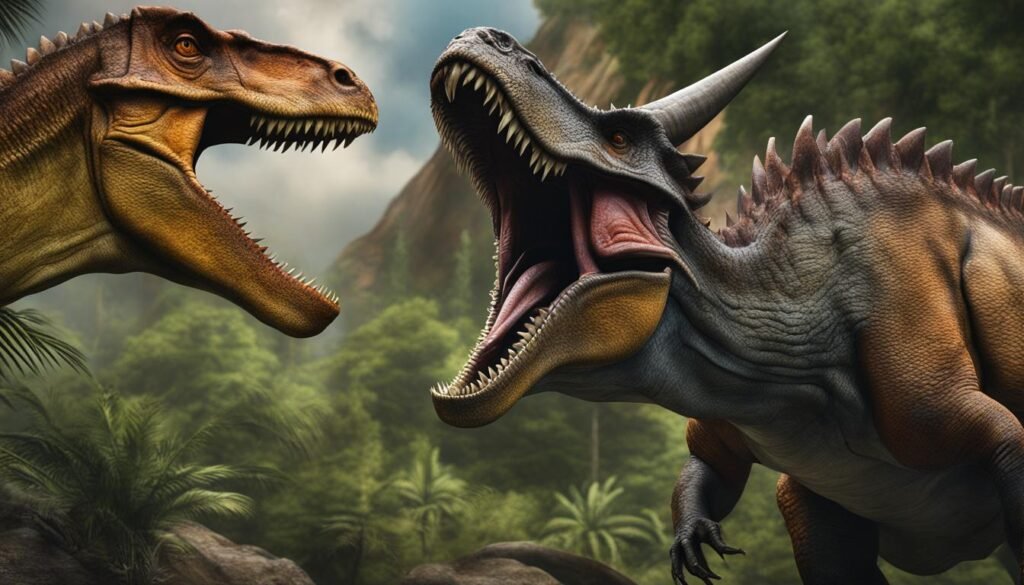
Size and Strength
In the world of dinosaurs, size and strength played a crucial role in their defense against predators. Some dinosaurs, like the mighty sauropods, were massive creatures with a sheer size that made them less vulnerable to attacks. Their towering presence and powerful bodies acted as a natural deterrent to potential predators.
Take, for example, the Argentinosaurus, one of the largest dinosaurs that ever roamed the Earth. It reached lengths of up to 100 feet and weighed an estimated 80 to 100 tons. With such immense size and bulk, it would have been nearly impossible for any predator to successfully take down such a colossal creature.
Moreover, dinosaurs with strong musculature and robust skeletons had the advantage of being able to withstand physical threats. This meant that even if they did encounter predators, their strength allowed them to fight back and defend themselves effectively.
| Dinosaur | Size | Estimated Weight |
|---|---|---|
| Argentinosaurus | Up to 100 feet | 80 to 100 tons |
| Tyrannosaurus rex | 40 to 43 feet | 6 to 9 tons |
| Spinosaurus | 41 to 59 feet | 7 to 20 tons |
This table highlights some of the largest and most powerful dinosaurs known to science. It’s fascinating to see the incredible dimensions and weight these creatures achieved, further showcasing their formidable defense against predators.
In conclusion, size and strength were essential defense mechanisms for dinosaurs. Their large size and robust bodies provided them with a natural protection against predators, making them less vulnerable to attacks. Exploring the impressive dimensions and weight of these ancient creatures gives us a glimpse into their world of survival in a dangerous prehistoric environment.
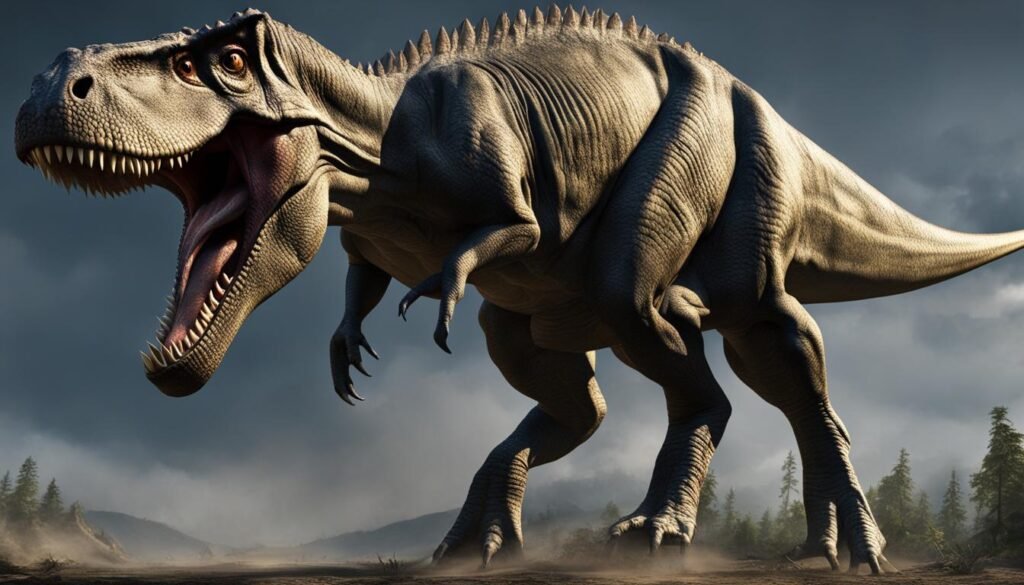
Group Defense and Territorial Behavior
In the dangerous world of dinosaurs, survival often depended on strength in numbers. Some species of dinosaurs employed group defense and territorial behavior as a defense mechanism, ensuring their collective safety and deterring potential predators.
Group Defense
Dinosaurs that lived and traveled in groups had a higher chance of survival than solitary individuals. By sticking together, they could effectively defend themselves against predators. One example of group defense is seen in the famous dinosaur species, Velociraptor. These small, agile predators hunted in packs, surrounding their prey and overwhelming it with their coordinated attacks. This strategy allowed them to take down much larger herbivorous dinosaurs.
Another fascinating example of group defense is exhibited by the dinosaur species known as Ankylosaurus. These heavily armored dinosaurs traveled in herds, providing protection to one another. With their thick bony plates and clubbed tails, Ankylosaurus could ward off even the most formidable predators. By staying together, they created a formidable barrier that discouraged attacks from potential threats.
Territorial Behavior
Dinosaurs also displayed territorial behavior as a means of defense. Just like modern animals, dinosaurs would mark and guard their territories, warding off intruders and potential predators. This behavior was particularly evident in dinosaur species such as Tyrannosaurus rex, which had vast home ranges and defended their territories fiercely. By claiming and defending their territory, dinosaurs could establish a safe space for feeding, mating, and raising their young.
Moreover, territorial behavior also played a role in mate selection and competition between males for dominance. This further ensured the survival and reproduction of the fittest individuals within the population.
In conclusion, group defense and territorial behavior were important defense mechanisms employed by dinosaurs to ensure their survival in a dangerous prehistoric world. By forming groups and defending their territories, dinosaurs could deter predators and protect themselves from harm. These strategies highlight the complexity of dinosaur behavior and the remarkable adaptations they evolved to navigate their environments.
Behavioral Strategies
Dinosaurs employed a variety of behavioral strategies as a means of defense against predators. These tactics allowed them to avoid confrontations, deter potential threats, and increase their chances of survival in a dangerous prehistoric environment.
1. Warning Displays: Some dinosaurs used warning displays to communicate their potential threat to predators. These displays could include vocalizations, body postures, or visual signals such as flaring crests or feathers. By effectively conveying their ability to defend themselves, these dinosaurs could discourage predators from approaching and avoid unnecessary conflicts.
2. Intimidation Tactics: Certain dinosaurs utilized intimidation tactics as a means of defense. These tactics involved aggressive behaviors such as bluff charges, aggressive posturing, or displaying their size and strength. By intimidating potential predators, these dinosaurs could discourage attacks and ensure their safety.
3. Predator Deterrence: Some dinosaurs had adaptations specifically designed to deter predators. For example, the Ankylosaurus had a tail club that it could use to defend itself against attackers. By utilizing their unique physical features as a deterrent, these dinosaurs could defend themselves effectively and avoid becoming prey.
These behavioral strategies, combined with the physical adaptations and survival tactics mentioned earlier, highlight the resourcefulness and adaptability of dinosaurs in defending themselves against predators.
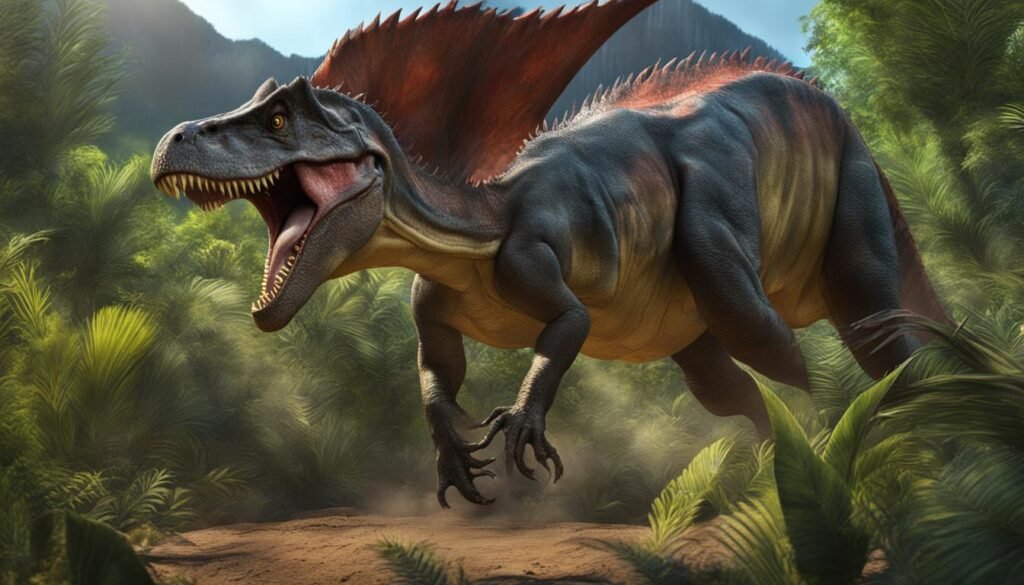
Examples of Behavioral Strategies in Dinosaurs
| Dinosaur | Behavioral Strategy |
|---|---|
| Stegosaurus | Displaying spiked plates as a warning signal |
| Triceratops | Charging at predators with their horns |
| Velociraptor | Utilizing pack hunting and coordinated attacks |
| Tyrannosaurus Rex | Roaring and displaying its size to intimidate rivals |
| Dilophosaurus | Exhibiting frilled head and vocalizations to deter predators |
Conclusion
In conclusion, dinosaurs had a variety of defense mechanisms and survival strategies to protect themselves in a world of predators. These adaptations included physical features like horns, claws, spikes, and body armor, as well as behavioral strategies like camouflage and group defense.
Physical adaptations played a crucial role in dinosaur defense. For instance, dinosaurs evolved specialized features such as claws, head butting, and whipping tails to deter predators and escape dangerous situations. Some dinosaurs even had body armor in the form of horns, plates, and spikes, providing additional protection.
Behavioral strategies were also key to dinosaur survival. Camouflage and mimicry allowed certain dinosaurs to blend into their surroundings or resemble other dangerous animals, avoiding detection by predators. Additionally, group defense and territorial behavior provided an effective defense mechanism, as staying in groups or defending territories helped deter predators and ensure safety.
By understanding these defense mechanisms, we gain valuable insights into the fascinating world of dinosaurs and their ability to survive in a dangerous prehistoric environment. The study of their survival strategies opens a window into the past, allowing us to marvel at their ingenuity and adaptability in the face of adversity.

